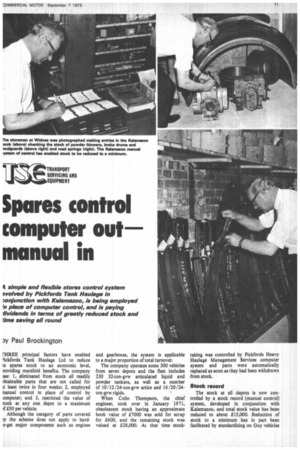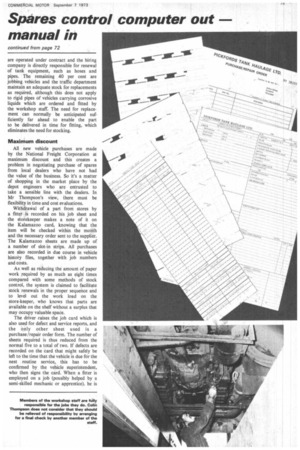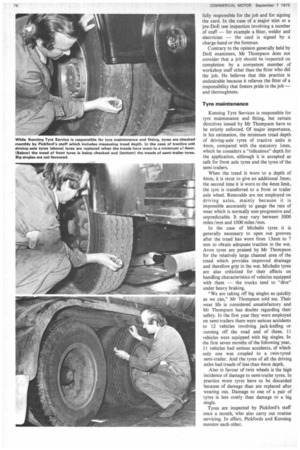Spares control computer out manual in
Page 73

Page 74

Page 77

Page 78

If you've noticed an error in this article please click here to report it so we can fix it.
)y Paul Brockington
CHREE principal factors have enabled nckfords Tank Haulage Ltd to reduce ts spares stock to an economic level, iroviding manifold benefits. The company las: 1, eliminated from stock all readily ibtainable parts that are not called for Li least twice in four weeks; 2, employed nanual control in place of control by ;omputer; and 3, restricted the value of took at any one depot to a maximum ,f50 per vehicle.
Although the category of parts covered )3/ the scheme does not apply to hardo-get major components such as engines and gearboxes, the system is applicable to a major proportion of total turnover.
The company operates some 300 vehicles from seven depots and the fleet includes 230 32-ton-gvw articulated liquid and powder tankers, as well as a number of 10/12 /24-ton-gvw artics and 16 /20 /24ton-gvw rigids.
When Colin Thompson, the chief engineer, took over in January 1971, obsolescent stock having an approximate book value of £7000 was sold for scrap for £600, and the remaining stock was valued at £28,000. At that time stock
taking was controUed by Pickfords Heavy Haulage Management Services computer system and parts were automatically replaced as soon as they had been withdrawn from stock.
Stock record
The stock at all depots is now controlled by a stock record (manual control) system, developed in conjunction with Kalamazoo, and total stock value has been reduced to about ilS,000. Reduction of stock to a minimum has in part been facilitated by standardizing on Guy vehicles for operations involving yearly mileages up to 50,000 and on ERF chassis for higher mileages, powered by Cummins or Rolls-Royce 220 bhp diesels.
The Kalamazoo system is described by Mr Thompson as simple and foolproof and one that ensures quick replacement of used parts as required. It was decided early on that a lot of data normally considered necessary was in fact unnecessary, including a record of every part's date of purchase, length of stay in the stores, date fitted and vehicle and job number. Instead, information on the Kalamazoo cards is restricted to: 1, shelf location; 2, simple description (such as flywheel rim, valve, brake lining and so on); 3, manufacturer's part number, and on the same line, list price and discount; 4, supplier or suppliers and delivery and 5, application.
In many cases "application" covers a variety of vehicles or more than one type of power unit. For example, a road spring may be suitable for Guy, Leyland or Seddon, a cal2 panel for a Guy or Seddon or an injector for a Rolls-Royce, AEC or Leyland. The information on the cards is all that a storekeeper wants, according to Mr Thompson. While planning involves an inspired guess of the rate of use and the appropirate number of items to keep in stock, this is no problem in the normal way and purchases are related to known delivery times.
Orders are geared to ordering on a monthly basis to restore stock to the original level. Changes in the rate of use can be accommodated over a relatively short period and this obviates over stocking and "built-in" obsolescence. If any part is used less than twice in four weeks the number in stock is reduced accordingly, or the number is increased to match a higher rate of use. The time scale is based on 13 four-week periods.
About 60 per cent of Pickfords tankers continued on page 75 are operated under contract and the hiring company is directly responsible for renewal of tank equipment, such as hoses and pipes. The remaining 40 per cent are jobbing vehicles and the traffic department maintain an adequate stock for replacements as required, although this does not apply to rigid pipes of vehicles carrying corrosive liquids which are ordered and fitted by the workshop staff. The need for replacement can normally be anticipated sufficiently far ahead to enable the part to be delivered in time for fitting, which eliminates the need for stocking.
Maximum discount All new vehicle purchases are made by the National Freight Corporation at maximum discount and this creates a problem in negotiating purchase of spares from local dealers who have not had the value of the business. So it's a matter of shopping in the market place by the depot engineers who are entrusted to take a sensible line with the dealers. In Mr Thompson's view, there must be flexibility in time and cost evaluations.
Withdrawal of a part from stores by a fitter is recorded on his job sheet and the storekeeper makes a note of it on the Kalamazoo card, knowing that the item will be checked within the month and the necessary order sent to the supplier. The Kalamazoo sheets are made up of a number of slot-in strips. All purchases are also recorded in due course in vehicle history files, together with job numbers and costs.
As well as reducing the amount of paper work required by as much as eight times compared with some methods of stock control, the system is claimed to facilitate stock renewals in the proper sequence and to level out the work load on the store-keeper, who knows that parts are available on the shelf without a surplus that may occupy valuable space.
The driver raises the job card which is also used for defect and service reports, and the Only other sheet used is a purchase/repair order form. The number of sheets required is thus reduced from the normal five to a total of two. If defects are recorded on the card that might safely be left to the time that the vehicle is due f6r the next routine service, this has to be confirmed by the vehicle superintendent,
who then signs the card. When a fitter is employed on a job (possibly helped by a semi-skilled mechanic or apprentice), he is
fully responsible for the job and for signing the card. In the case of a major stint or a "pre-DoE test inspection involving a number of staff — for example a fitter, welder and electrician — the card is signed by a charge-hand or the foreman.
Contrary to the opinion generally held by DoE examiners, Mr Thompson does not consider that a job should be inspected on completion by a competent member of workshop staff other than the fitter who did the job. He believes that this practice is undesirable because it relieves the fitter of a responsibility that fosters pride in the job — and thoroughness.
Tyre maintenance Kenning Tyre Services is responsible for tyre maintenance and fitting, but certain directives issued by Mr Thompson have to be strictly enforced. Of major importance, in his estimation, the minimum tread depth of driving-axle tyres of tractive units is 4mm, compared with the statutory Imm, which he considers a "ridiculous" depth for the application, although it is accepted as safe for front axle tyres and the tyres of the semi-trailers.
When the.tread is worn to a depth of 4mm, it is recut to give an additional 3mm; the second time it is worn to the 4mm limit, the tyre is transferred to a front or trailer axle wheel. Remoulds are not employed on driving axles, mainly because it is impossible accurately to gauge the rate of wear which is normally non-progressive and. unpredictable. It may vary between 3000 miles/mm and 1000 miles /mm.
In the case of Michelin tyres it is generally necessary to open out grooves after the tread has worn from 13mm to 7 mm to obtain adequate traction in the wet. Avon tyres are praised by Mr Thompson for the relatively large channel area of the tread which provides improved drainage and therefore grip in the wet. Michelin tyres are also criticized for their effects on handling characteristics of vehicles equipped with them — the trucks tend to "dive" under heavy braking.
"We are taking off big singles as quickly as we can," Mr Thompson told me. Their wear life is considered unsatisfactory and Mr Thompson has doubts regarding their safety. In the first year they were employed on semi-trailers there were serious accidents to 12 vehicles involving jack-knifing or running off the road and of these, 11 vehicles were equipped with big singles. In the first seven months of the following year, 11 vehicles had serious accidents, of which only one was coupled to a twin-tyred semi-trailer. And the tyres of all the driving axles had treads of less than 4mm depth.
Also in favour of twin wheels is the high incidence of damage to semi-trailer tyres. In practice more tyres have to be discarded because of damage than are replaced after wearing out. Damage to one of a pair of tyres is less costly than damage to a big single.
Tyres are inspected by Pickford's staff once a month, who also carry out routine servicing. In effect, Pickfords and Kenning monitor each other.








































































































































